3.1: How Microscopes Work
- Page ID
- 31770
Learning Objectives
- Identify and define the characteristics of electromagnetic radiation (EMR) used in microscopy
- Explain how lenses are used in microscopy to manipulate visible and ultraviolet (UV) light
- Describe historical developments and individual contributions that led to the invention and development of the microscope
- Compare and contrast the features of simple and compound microscopes
- Identify and describe the parts of a brightfield microscope
- Calculate total magnification for a compound microscope
- Describe the distinguishing features and typical uses for various types of light microscopes, and electron microscopes.
Clinical Focus: part 1
Cindy, a 17-year-old counselor at a summer sports camp, scraped her knee playing basketball 2 weeks ago. At the time, she thought it was only a minor abrasion that would heal, like many others before it. Instead, the wound began to look like an insect bite and has continued to become increasingly painful and swollen.
The camp nurse examines the lesion and observes a large amount of pus oozing from the surface. Concerned that Cindy may have developed a potentially aggressive infection, she swabs the wound to collect a sample from the infection site. Then she cleans out the pus and dresses the wound, instructing Cindy to keep the area clean and to come back the next day. When Cindy leaves, the nurse sends the sample to the closest medical lab to be analyzed under a microscope.
Exercise \(\PageIndex{1}\)
What are some things we can learn about these bacteria by looking at them under a microscope?
Visible light consists of electromagnetic waves that behave like other waves. Hence, many of the properties of light that are relevant to microscopy can be understood in terms of light’s behavior as a wave. An important property of light waves is the wavelength, or the distance between one peak of a wave and the next peak. The height of each peak (or depth of each trough) is called the amplitude. In contrast, the frequency of the wave is the rate of vibration of the wave, or the number of wavelengths within a specified time period (Figure \(\PageIndex{1}\)).

Interactions of Light
Light waves interact with materials by being reflected, absorbed, or transmitted. Reflection occurs when a wave bounces off of a material. For example, a red piece of cloth may reflect red light to our eyes while absorbing other colors of light. Absorbance occurs when a material captures the energy of a light wave. In the case of glow-in-the-dark plastics, the energy from light can be absorbed and then later re-emitted as another form of phosphorescence. Transmission occurs when a wave travels through a material, like light through glass (the process of transmission is called transmittance). When a material allows a large proportion of light to be transmitted, it may do so because it is thinner, or more transparent (having more transparency and less opacity). Figure \(\PageIndex{2}\) illustrates the difference between transparency and opacity.

Exercise \(\PageIndex{2}\)
- If a light wave has a long wavelength, is it likely to have a low or high frequency?
- If an object is transparent, does it reflect, absorb, or transmit light?
Lenses and Refraction
In the context of microscopy, refraction is perhaps the most important behavior exhibited by light waves. Refraction occurs when light waves change direction as they enter a new medium (Figure \(\PageIndex{3}\)). Different transparent materials transmit light at different speeds; thus, light can change speed when passing from one material to another. This change in speed usually also causes a change in direction (refraction), with the degree of change dependent on the angle of the incoming light.
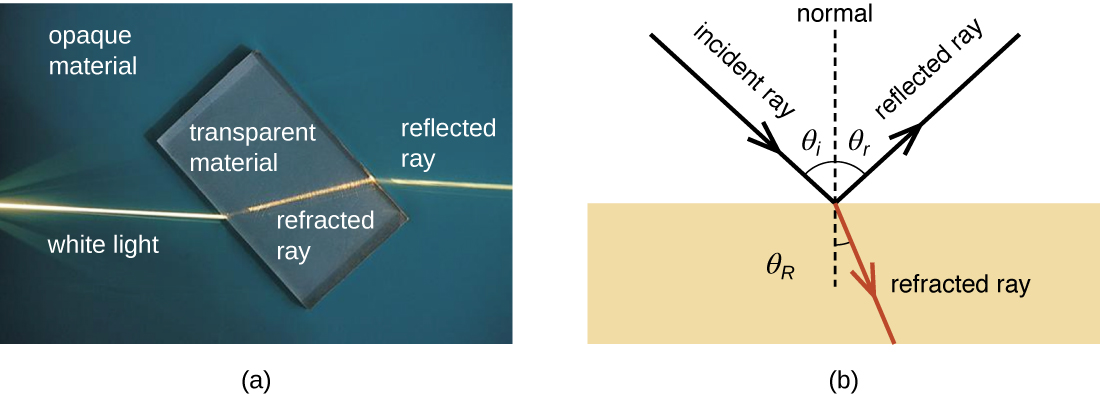
The extent to which a material slows transmission speed relative to empty space is called the refractive index of that material. Large differences between the refractive indices of two materials will result in a large amount of refraction when light passes from one material to the other. For example, light moves much more slowly through water than through air, so light entering water from air can change direction greatly. We say that the water has a higher refractive index than air (Figure \(\PageIndex{4}\)).
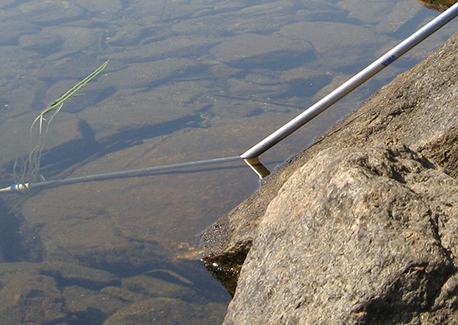
When light crosses a boundary into a material with a higher refractive index, its direction turns to be closer to perpendicular to the boundary (i.e., more toward a normal- the same angle- to that boundary; Figure \(\PageIndex{5}\)). This is the principle behind lenses. We can think of a lens as an object with a curved boundary (or a collection of prisms) that collects all of the light that strikes it and refracts it so that it all meets at a single point called the focus point (or image point). A convex lens can be used to magnify because it can focus at closer range than the human eye, producing a larger image. Concave lenses and mirrors can also be used in microscopes to redirect the light path. Figure \(\PageIndex{5}\) shows the focal point (the image point when light entering the lens is parallel) and the focal length (the distance to the focal point) for convex and concave lenses.

The human eye contains a lens that enables us to see images. This lens focuses the light reflecting off of objects in front of the eye onto the surface of the retina, which is like a screen in the back of the eye. Artificial lenses placed in front of the eye (contact lenses, glasses, or microscopic lenses) focus light before it is focused (again) by the lens of the eye, manipulating the image that ends up on the retina (e.g., by making it appear larger).
Images are commonly manipulated by controlling the distances between the object, the lens, and the screen, as well as the curvature of the lens. For example, for a given amount of curvature, when an object is closer to the lens, the focal points are farther from the lens. As a result, it is often necessary to manipulate these distances to create a focused image on a screen. Similarly, more curvature creates image points closer to the lens and a larger image when the image is in focus. This property is often described in terms of the focal distance, or distance to the focal point.
Exercise \(\PageIndex{3}\)
- Explain how a lens focuses light at the image point.
- Name some factors that affect the focal length of a lens.
Electromagnetic Spectrum and Color
Visible light is just one form of electromagnetic radiation (EMR), a type of energy that is all around us. Other forms of EMR include microwaves, X-rays, and radio waves, among others. The different types of EMR fall on the electromagnetic spectrum, which is defined in terms of wavelength and frequency. The spectrum of visible light occupies a relatively small range of frequencies between infrared and ultraviolet light (Figure \(\PageIndex{6}\)).

Whereas wavelength represents the distance between adjacent peaks of a light wave, frequency, in a simplified definition, represents the rate of oscillation. Waves with higher frequencies have shorter wavelengths and, therefore, have more oscillations per unit time than lower-frequency waves. Higher-frequency waves also contain more energy than lower-frequency waves. This energy is delivered as elementary particles called photons. Higher-frequency waves deliver more energetic photons than lower-frequency waves.
Photons with different energies interact differently with the retina. In the spectrum of visible light, each color corresponds to a particular frequency and wavelength (Figure \(\PageIndex{6}\)).The lowest frequency of visible light appears as the color red, whereas the highest appears as the color violet. When the retina receives visible light of many different frequencies, we perceive this as white light. However, white light can be separated into its component colors using refraction. If we pass white light through a prism, different colors will be refracted in different directions, creating a rainbow-like spectrum on a screen behind the prism. This separation of colors is called dispersion, and it occurs because, for a given material, the refractive index is different for different frequencies of light.
Certain materials can refract nonvisible forms of EMR and, in effect, transform them into visible light. Certain fluorescent dyes, for instance, absorb ultraviolet or blue light and then use the energy to emit photons of a different color, giving off light rather than simply vibrating. This occurs because the energy absorption causes electrons to jump to higher energy states, after which they then almost immediately fall back down to their ground states, emitting specific amounts of energy as photons. Not all of the energy is emitted in a given photon, so the emitted photons will be of lower energy and, thus, of lower frequency than the absorbed ones. Thus, a dye such as Texas red may be excited by blue light, but emit red light; or a dye such as fluorescein isothiocyanate (FITC) may absorb (invisible) high-energy ultraviolet light and emit green light (Figure \(\PageIndex{7}\)). In some materials, the photons may be emitted following a delay after absorption; in this case, the process is called phosphorescence. Glow-in-the-dark plastic works by using phosphorescent material.
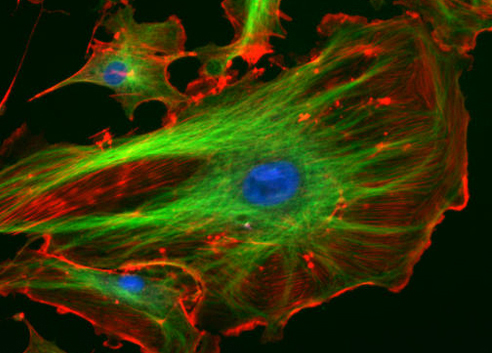
Exercise \(\PageIndex{4}\)
- Which has a higher frequency: red light or green light?
- Explain why dispersion occurs when white light passes through a prism.
- Why do fluorescent dyes emit a different color of light than they absorb?
Magnification, Resolution, and Contrast
Microscopes magnify images and use the properties of light to create useful images of small objects. Magnification is defined as the ability of a lens to enlarge the image of an object when compared to the real object. For example, a magnification of 10⨯ means that the image appears 10 times the size of the object as viewed with the naked eye.
Greater magnification typically improves our ability to see details of small objects, but magnification alone is not sufficient to make the most useful images. It is often useful to enhance the resolution of objects: the ability to tell that two separate points or objects are separate. A low-resolution image appears fuzzy, whereas a high-resolution image appears sharp. Two factors affect resolution. The first is wavelength. Shorter wavelengths are able to resolve smaller objects; thus, an electron microscope has a much higher resolution than a light microscope, since it uses an electron beam with a very short wavelength, as opposed to the long-wavelength visible light used by a light microscope. The second factor that affects resolution is numerical aperture, which is a measure of a lens’s ability to gather light. The higher the numerical aperture, the better the resolution.
Even when a microscope has high resolution, it can be difficult to distinguish small structures in many specimens because microorganisms are relatively transparent. It is often necessary to increase contrast to detect different structures in a specimen. Various types of microscopes use different features of light or electrons to increase contrast—visible differences between the parts of a specimen. Additionally, dyes that bind to some structures but not others can be used to improve the contrast between images of relatively transparent objects.
Exercise \(\PageIndex{5}\)
- Explain the difference between magnification and resolution.
- Explain the difference between resolution and contrast.
- Name two factors that affect resolution.
The Early Microscope
Some of the fundamental characteristics and functions of microscopes can be understood in the context of the history of their use. Italian scholar Girolamo Fracastoro is regarded as the first person to formally postulate that disease was spread by tiny invisible seminaria, or “seeds of the contagion.” In his book De Contagione (1546), he proposed that these seeds could attach themselves to certain objects (which he called fomes [cloth]) that supported their transfer from person to person. However, since the technology for seeing such tiny objects did not yet exist, the existence of the seminaria remained hypothetical for a little over a century—an invisible world waiting to be revealed.
Who Invented the Microscope?
While Antonie van Leeuwenhoek and Robert Hooke generally receive much of the credit for early advances in microscopy, neither can claim to be the inventor of the microscope. While van Leeuwenhoek is credited with the discovery of microorganisms, others before him had contributed to the development of the microscope. These included the Italian astronomer Galileo Galilei, who used a compound microscope to examine insect parts . Whereas van Leeuwenhoek used a simple microscope, in which light is passed through just one lens, Galileo’s compound microscope was more sophisticated, passing light through two sets of lenses.
Some argue that this designation of inventor should belong to Hans and Zaccharias Janssen, Dutch spectacle-makers who may have invented the telescope, the simple microscope, and the compound microscope during the late 1500s or early 1600s (Figure \(\PageIndex{8}\)). Unfortunately, little is known for sure about the Janssens, not even the exact dates of their births and deaths. The Janssens were secretive about their work and never published. It is also possible that the Janssens did not invent anything at all; their neighbor, Hans Lippershey, also developed microscopes and telescopes during the same time frame, and he is often credited with inventing the telescope. The historical records from the time are as fuzzy and imprecise as the images viewed through those early lenses, and any archived records have been lost over the centuries.

By contrast, van Leeuwenhoek and Hooke can thank ample documentation of their work for their respective legacies. Like Janssen, van Leeuwenhoek began his work in obscurity, leaving behind few records. However, his friend, the prominent physician Reinier de Graaf, wrote a letter to the editor of the Philosophical Transactions of the Royal Society of London calling attention to van Leeuwenhoek’s powerful microscopes. From 1673 onward, van Leeuwenhoek began regularly submitting letters to the Royal Society detailing his observations. In 1674, his report describing single-celled organisms produced controversy in the scientific community, but his observations were soon confirmed when the society sent a delegation to investigate his findings. He subsequently enjoyed considerable celebrity, at one point even entertaining a visit by the czar of Russia.
Similarly, Robert Hooke had his observations using microscopes published by the Royal Society in a book called Micrographia in 1665. The book became a bestseller and greatly increased interest in microscopy throughout much of Europe.
Modern Microscopy
The early pioneers of microscopy opened a window into the invisible world of microorganisms. But microscopy continued to advance in the centuries that followed. In 1830, Joseph Jackson Lister created an essentially modern light microscope. The 20th century saw the development of microscopes that leveraged nonvisible light, such as fluorescence microscopy, which uses an ultraviolet light source, and electron microscopy, which uses short-wavelength electron beams. These advances led to major improvements in magnification, resolution, and contrast. By comparison, the relatively rudimentary microscopes of van Leeuwenhoek and his contemporaries were far less powerful than even the most basic microscopes in use today. In this section, we will focus on the most common and applications for each type of microscope.
Light Microscopy
Many types of microscopes fall under the category of light microscopes, which use light to visualize images. Examples of light microscopes include brightfield microscopes, darkfield microscopes, phase-contrast microscopes, differential interference contrast microscopes, fluorescence microscopes, confocal scanning laser microscopes, and two-photon microscopes. These various types of light microscopes can be used to complement each other in diagnostics and research. We will just focus on brightfield, the most common type to be used in labs.
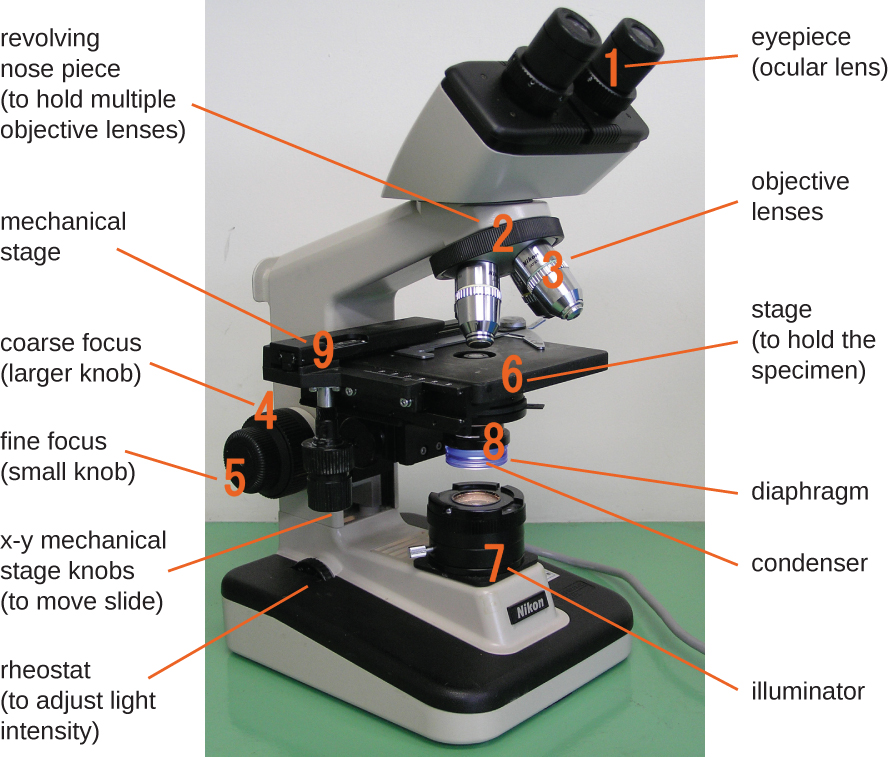
Components of a Typical Brightfield Microscope
The item being viewed is called a specimen. The specimen is placed on a glass slide, which is then clipped into place on the stage(a platform) of the microscope. Once the slide is secured, the specimen on the slide is positioned over the light using the x-y mechanical stage knobs. These knobs move the slide on the surface of the stage, but do not raise or lower the stage. Once the specimen is centered over the light, the stage position can be raised or lowered to focus the image. The coarse focusing knob is used for large-scale movements with 4⨯ and 10⨯ objective lenses; the fine focusing knob is used for small-scale movements, especially with 40⨯ or 100⨯ objective lenses.
When images are magnified, they become dimmer because there is less light per unit area of image. Highly magnified images produced by microscopes, therefore, require intense lighting. In a brightfield microscope, this light is provided by an illuminator, which is typically a high-intensity bulb below the stage. Light from the illuminator passes up through condenser lens (located below the stage), which focuses all of the light rays on the specimen to maximize illumination. The position of the condenser can be optimized using the attached condenser focus knob; once the optimal distance is established, the condenser should not be moved to adjust the brightness. If less-than-maximal light levels are needed, the amount of light striking the specimen can be easily adjusted by opening or closing a diaphragm between the condenser and the specimen. In some cases, brightness can also be adjusted using the rheostat, a dimmer switch that controls the intensity of the illuminator.
A brightfield microscope creates an image by directing light from the illuminator at the specimen; this light is differentially transmitted, absorbed, reflected, or refracted by different structures. Different colors can behave differently as they interact with chromophores (pigments that absorb and reflect particular wavelengths of light) in parts of the specimen. Often, chromophores are artificially added to the specimen using stains, which serve to increase contrast and resolution. In general, structures in the specimen will appear darker, to various extents, than the bright background, creating maximally sharp images at magnifications up to about 1000⨯. Further magnification would create a larger image, but without increased resolution. This allows us to see objects as small as bacteria, which are visible at about 400⨯ or so, but not smaller objects such as viruses.
At very high magnifications, resolution may be compromised when light passes through the small amount of air between the specimen and the lens. This is due to the large difference between the refractive indices of air and glass; the air scatters the light rays before they can be focused by the lens. To solve this problem, a drop of oil can be used to fill the space between the specimen and an oil immersion lens, a special lens designed to be used with immersion oils. Since the oil has a refractive index very similar to that of glass, it increases the maximum angle at which light leaving the specimen can strike the lens. This increases the light collected and, thus, the resolution of the image (Figure \(\PageIndex{10}\)). A variety of oils can be used for different types of light.
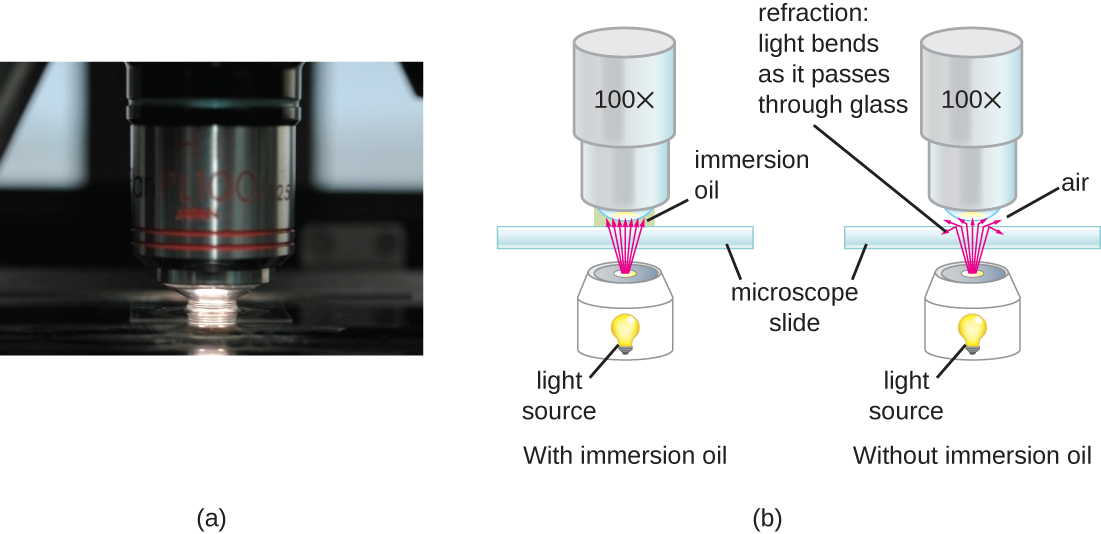
Brightfield Microscopes
The brightfield microscope, perhaps the most commonly used type of microscope, is a compound microscope with two or more lenses that produce a dark image on a bright background. Some brightfield microscopes are monocular (having a single eyepiece), though most newer brightfield microscopes are binocular (having two eyepieces), like the one shown in Figure \(\PageIndex{9}\); in either case, each eyepiece contains a lens called an ocular lens. The ocular lenses typically magnify images 10 times (10⨯). At the other end of the body tube are a set of objective lenses on a rotating nosepiece. The magnification of these objective lenses typically ranges from 4⨯ to 100⨯, with the magnification for each lens designated on the metal casing of the lens. The ocular and objective lenses work together to create a magnified image. The total magnification is the product of the ocular magnification times the objective magnification:
\[\text{ocular magnification}\; \times\; \text{objective magnification}\]
For example, if a 40⨯ objective lens is selected and the ocular lens is 10⨯, the total magnification would be
(40×)(10×)=400×
Microscope Maintenance: Best Practices
Even a very powerful microscope cannot deliver high-resolution images if it is not properly cleaned and maintained. Since lenses are carefully designed and manufactured to refract light with a high degree of precision, even a slightly dirty or scratched lens will refract light in unintended ways, degrading the image of the specimen. In addition, microscopes are rather delicate instruments, and great care must be taken to avoid damaging parts and surfaces. Among other things, proper care of a microscope includes the following:
- cleaning the lenses with lens paper
- not allowing lenses to contact the slide (e.g., by rapidly changing the focus)
- protecting the bulb (if there is one) from breakage
- not pushing an objective into a slide
- not using the coarse focusing knob when using the 40⨯ or greater objective lenses
- only using immersion oil with a specialized oil objective, usually the 100⨯ objective
- cleaning oil from immersion lenses after using the microscope
- cleaning any oil accidentally transferred from other lenses
- covering the microscope and/or placing it in a cabinet when not in use
Electron Microscopy
The maximum theoretical resolution of images created by light microscopes is ultimately limited by the wavelengths of visible light. Most light microscopes can only magnify 1000⨯, and a few can magnify up to 1500⨯, but this does not begin to approach the magnifying power of an electron microscope (EM), which uses short-wavelength electron beams rather than light to increase magnification and resolution.
Electrons, like electromagnetic radiation, can behave as waves, but with wavelengths of 0.005 nm, they can produce much better resolution than visible light. An EM can produce a sharp image that is magnified up to 100,000⨯. Thus, EMs can resolve subcellular structures as well as some molecular structures (e.g., single strands of DNA); however, electron microscopy cannot be used on living material because of the methods needed to prepare the specimens.
There are two basic types of EM: the transmission electron microscope (TEM) and the scanning electron microscope (SEM)(Figure \(\PageIndex{11}\)). The TEM is somewhat analogous to the brightfield light microscope in terms of the way it functions. However, it uses an electron beam from above the specimen that is focused using a magnetic lens (rather than a glass lens) and projected through the specimen onto a detector. Electrons pass through the specimen, and then the detector captures the image (Figure \(\PageIndex{12}\)).
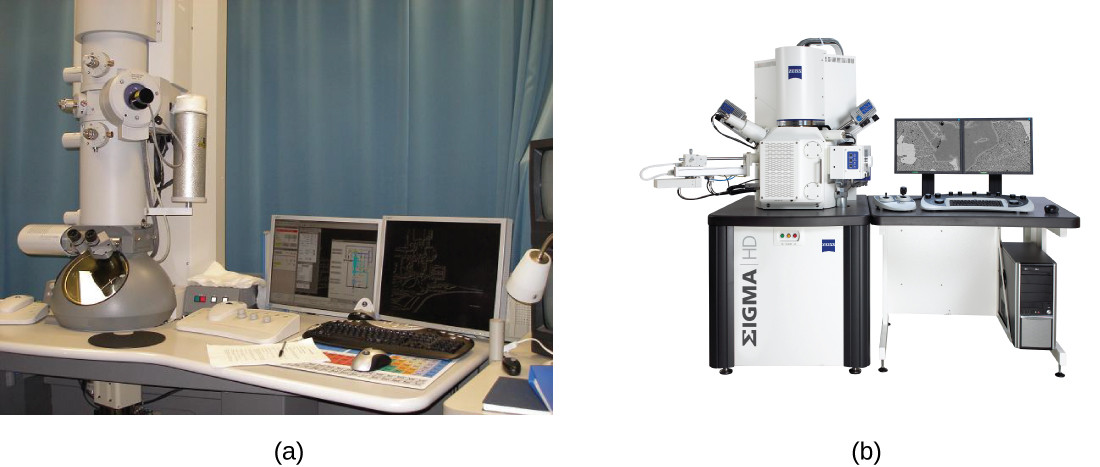
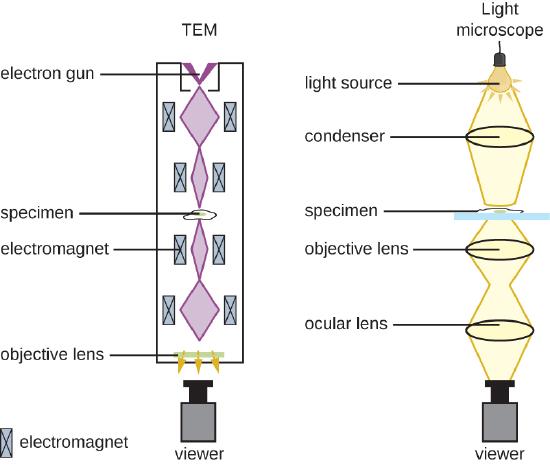
For electrons to pass through the specimen in a TEM, the specimen must be extremely thin (20–100 nm thick). The image is produced because of varying opacity in various parts of the specimen. This opacity can be enhanced by staining the specimen with materials such as heavy metals, which are electron dense. TEM requires that the beam and specimen be in a vacuum and that the specimen be very thin and dehydrated. The specific steps needed to prepare a specimen for observation under an EM are discussed in detail in the next section.
SEMs form images of surfaces of specimens, usually from electrons that are knocked off of specimens by a beam of electrons. This can create highly detailed images with a three-dimensional appearance that are displayed on a monitor (Figure \(\PageIndex{13}\)). Typically, specimens are dried and prepared with fixatives that reduce artifacts, such as shriveling, that can be produced by drying, before being sputter-coated with a thin layer of metal such as gold. Whereas transmission electron microscopy requires very thin sections and allows one to see internal structures such as organelles and the interior of membranes, scanning electron microscopy can be used to view the surfaces of larger objects (such as a pollen grain) as well as the surfaces of very small samples (Figure \(\PageIndex{14}\)). Some EMs can magnify an image up to 2,000,000⨯.1
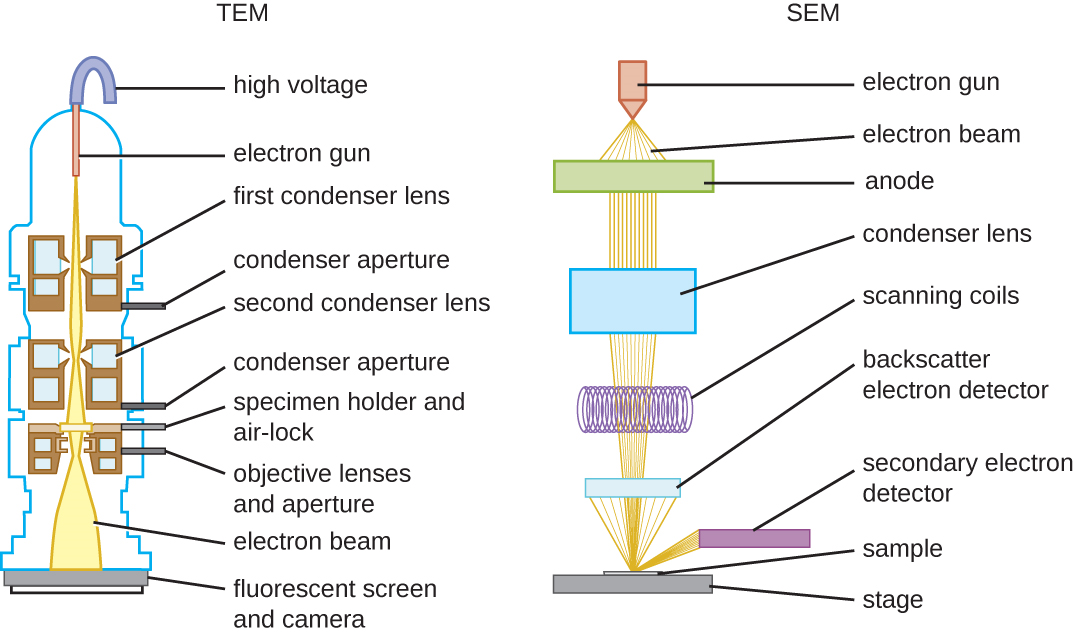
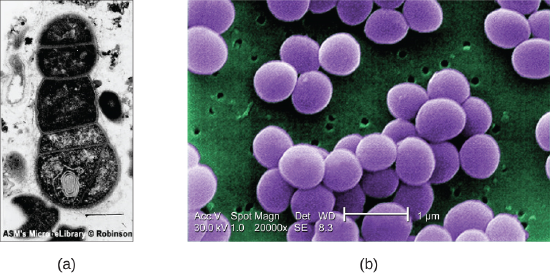
Exercise \(\PageIndex{6}\)
- What are some advantages and disadvantages of electron microscopy, as opposed to light microscopy, for examining microbiological specimens?
- What kinds of specimens are best examined using TEM? SEM?

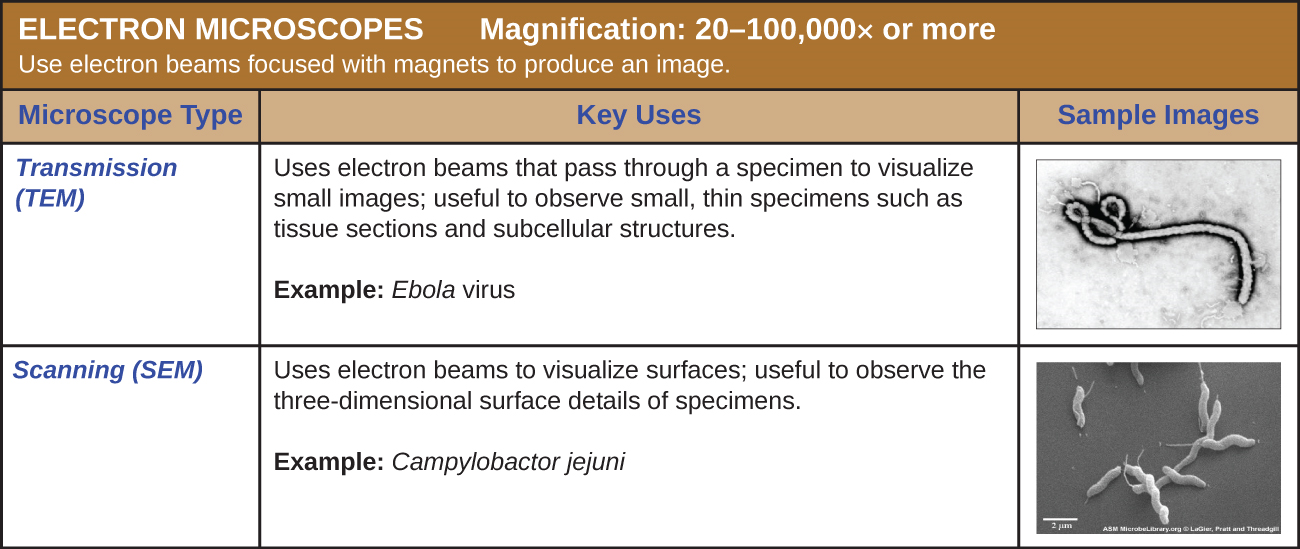
Key Concepts and Summary
- Light waves interacting with materials may be reflected, absorbed, or transmitted, depending on the properties of the material.
- Light waves can interact with each other (interference) or be distorted by interactions with small objects or openings (diffraction).
- Refraction occurs when light waves change speed and direction as they pass from one medium to another. Differences in the refraction indices of two materials determine the magnitude of directional changes when light passes from one to the other.
- A lens is a medium with a curved surface that refracts and focuses light to produce an image.
- Visible light is part of the electromagnetic spectrum; light waves of different frequencies and wavelengths are distinguished as colors by the human eye.
- A prism can separate the colors of white light (dispersion) because different frequencies of light have different refractive indices for a given material.
- Fluorescent dyes and phosphorescent materials can effectively transform nonvisible electromagnetic radiation into visible light.
- The power of a microscope can be described in terms of its magnification and resolution.
- Resolution can be increased by shortening wavelength, increasing the numerical aperture of the lens, or using stains that enhance contrast.
- Antonie van Leeuwenhoek is credited with the first observation of microbes, including protists and bacteria, with simple microscopes that he made.
- Robert Hooke was the first to describe what we now call cells.
- Simple microscopes have a single lens, while compound microscopes have multiple lenses.
- Numerous types of microscopes use various technologies to generate micrographs. Most are useful for a particular type of specimen or application.
- Light microscopy uses lenses to focus light on a specimen to produce an image. Commonly used light microscopes include brightfield, darkfield, phase-contrast, differential interference contrast, fluorescence, confocal, and two-photon microscopes.
- Electron microscopy focuses electrons on the specimen using magnets, producing much greater magnification than light microscopy. The transmission electron microscope (TEM) and scanning electron microscope (SEM) are two common forms.
Glossary
- absorbance
- when a molecule captures energy from a photon and vibrates or stretches, using the energy
- amplitude
- the height of a wave
- brightfield microscope
- a compound light microscope with two lenses; it produces a dark image on a bright background
- chromophores
- pigments that absorb and reflect particular wavelengths of light (giving them a color)
- coarse focusing knob
- a knob on a microscope that produces relatively large movements to adjust focus
- condenser lens
- a lens on a microscope that focuses light from the light source onto the specimen
- contrast
- visible differences between parts of a microscopic specimen
- compound microscope
- a microscope that uses multiple lenses to focus light from the specimen
- diaphragm
- a component of a microscope; typically consists of a disk under the stage with holes of various sizes; can be adjusted to allow more or less light from the light source to reach the specimen
- diffraction
- the changing of direction (bending or spreading) that occurs when a light wave interacts with an opening or barrier
- dispersion
- the separation of light of different frequencies due to different degrees of refraction
- electron microscope
- a type of microscope that uses short-wavelength electron beams rather than light to increase magnification and resolution
- fine focusing knob
- a knob on a microscope that produces relatively small movements to adjust focus
- fluorescent
- the ability of certain materials to absorb energy and then immediately release that energy in the form of light
- focal length
- the distance from the lens to the image point when the object is at a definite distance from the lens (this is also the distance to the focal point)
- focal point
- a property of the lens; the image point when light entering the lens is parallel (i.e., the object is an infinite distance from the lens)
- frequency
- the rate of vibration for a light wave or other electromagnetic wave
Footnotes
- illuminator
- the light source on a microscope
- image point (focus)
- a property of the lens and the distance of the object to the lens; the point at which an image is in focus (the image point is often called the focus)
- interference
- distortion of a light wave due to interaction with another wave
- magnification
- the power of a microscope (or lens) to produce an image that appears larger than the actual specimen, expressed as a factor of the actual size
- numerical aperture
- a measure of a lens’s ability to gather light
- objective lenses
- on a light microscope, the lenses closest to the specimen, typically located at the ends of turrets
- ocular lens
- on a microscope, the lens closest to the eye (also called an eyepiece)
- oil immersion lens
- a special objective lens on a microscope designed to be used with immersion oil to improve resolution
- opacity
- the property of absorbing or blocking light
- phosphorescence
- the ability of certain materials to absorb energy and then release that energy as light after a delay
- reflection
- when light bounces back from a surface
- refraction
- bending of light waves, which occurs when a light wave passes from one medium to another
- refractive index
- a measure of the magnitude of slowing of light waves by a particular medium
- resolution
- the ability to distinguish between two points in an image
- rheostat
- a dimmer switch that controls the intensity of the illuminator on a light microscope
- scanning electron microscope (SEM)
- a type of electron microscope that bounces electrons off of the specimen, forming an image of the surface
- simple microscope
- a type of microscope with only one lens to focus light from the specimen
- stage
- the platform of a microscope on which slides are placed
- total magnification
- in a light microscope is a value calculated by multiplying the magnification of the ocular by the magnification of the objective lenses
- transmission electron microscope (TEM)
- a type of electron microscope that uses an electron beam, focused with magnets, that passes through a thin specimen
- transmittance
- the amount of light that passes through a medium
- transparency
- the property of allowing light to pass through
- wavelength
- the distance between one peak of a wave and the next peak
- x-y mechanical stage knobs
- knobs on a microscope that are used to adjust the position of the specimen on the stage surface, generally to center it directly above the light
- 1 “JEM-ARM200F Transmission Electron Microscope,” JEOL USA Inc, www.jeolusa.com/PRODUCTS/Tran...specifications. Accessed 8/28/2015.
Contributor
Nina Parker, (Shenandoah University), Mark Schneegurt (Wichita State University), Anh-Hue Thi Tu (Georgia Southwestern State University), Philip Lister (Central New Mexico Community College), and Brian M. Forster (Saint Joseph’s University) with many contributing authors. Original content via Openstax (CC BY 4.0; Access for free at https://openstax.org/books/microbiology/pages/1-introduction)


